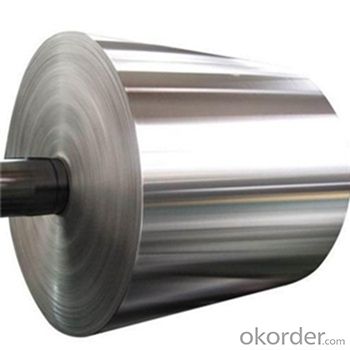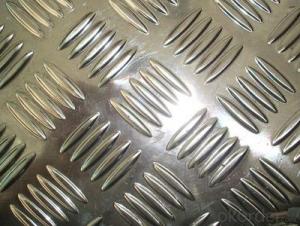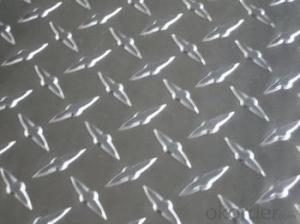Diamond Aluminum Sheet For Embossing sheet
- Loading Port:
- Shanghai
- Payment Terms:
- TT OR LC
- Min Order Qty:
- 1 m.t.
- Supply Capability:
- 1999 m.t./month
OKorder Service Pledge
OKorder Financial Service
You Might Also Like
Item specifice
1100-H14-DIAMOND EMBOSSED ALUMINUM SHEET
Thickness:1.2mm---4mm,
width:1000mm---1500mm
Product code: 618 a - 33 y titanium matte aluminum plate
Technical parameters
Aluminum alloy/material: 1100
Tensile strength N/was: 115-125
The yield strength of N/was: 150-150
Elongation % : 3 or more
Rainbow degrees: no
Process: light oxidation process
Product description: surface "colored metal silken face" as the main characteristics of the product, completely metal texture, color variety, products can be mild tensile and bending.
Product use: can be used to directly shape stamping, screen printing, thermal transfer two composite process, etc.Used in architectural decoration, household appliances, switch panel, auto parts, lamps lighting, electronic hardware and other industries.
Supply scope of coil or sheet
Mm thickness specification: 0.4 1
Maximum width mm: 1250
The tolerance range
Mm thickness: 0.02 mm
The width of the mm: 2 -
Mm length: 2 -
Actual weight kg: plus or minus 2
Protective film
Protective film on the surface of the aluminum quality assurance period for six months, aluminum is kept dry and ventilated, avoid heat and direct sunlight.If the aluminium material stored in high temperature or direct sunlight can cause protective film, or unable to tear in addition to wait for a phenomenon.

- Q:What are the different methods of surface patterning aluminum sheets?
- Aluminum sheets can be patterned using a variety of methods, each with its own benefits and applications. Some commonly used techniques include: 1. Mechanical Etching: By employing abrasive materials like sandpaper or wire brushes, patterns can be created on the aluminum surface. Different pressures and movements can be applied to achieve desired designs. Mechanical etching is a versatile and cost-effective method suitable for both simple and complex patterns. 2. Chemical Etching: Also known as chemical milling, this method involves using chemicals to selectively remove material from the aluminum surface and form patterns. The aluminum sheet is coated with a resist and then submerged in an etchant solution, which dissolves the exposed areas, leaving behind the desired pattern. Chemical etching allows for precise and intricate designs but requires careful control of the etching process. 3. Laser Engraving: This technique utilizes a high-power laser beam to remove material from the aluminum surface and create patterns. The laser beam is controlled by computer software, enabling precise and detailed designs. Laser engraving is suitable for both small and large-scale production, offering high accuracy and repeatability. 4. Embossing: In this method, the aluminum sheet is pressed between two dies with raised patterns, resulting in a three-dimensional design on the surface. Embossing can be achieved through mechanical or hydraulic presses and is commonly used to add texture and aesthetic appeal to aluminum sheets, such as for decorative purposes or branding. 5. Printing: Various printing techniques can be employed to apply patterns onto aluminum sheets. These include screen printing, which involves forcing ink through a mesh screen onto the aluminum surface, and digital printing, which utilizes inkjet technology for high-resolution patterns. Printing methods allow for a wide range of colors and designs, making them suitable for decorative applications. The choice of surface patterning method depends on factors such as desired pattern complexity, production volume, cost considerations, and the intended end-use of the aluminum sheets. Each method offers distinct advantages and limitations, allowing manufacturers to select the most suitable technique according to their specific requirements.
- Q:I have some carbon arrows for my bow but I was wondering if aluminum arrows penetrate farther into a deer because they weigh more. I read somewhere that they do but I just wanted to confirm that.
- Aluminium weight more than carbon arrow, so it will drop more.
- Q:What is the typical thickness tolerance for aluminum sheets?
- The specific application and industry standards can cause variations in the typical thickness tolerance for aluminum sheets. Generally, the acceptable range for thickness tolerance is usually between ± 0.005 and ± 0.015 inches. This indicates that the actual thickness of the sheet can deviate within this tolerance range from the specified thickness. It is worth noting that diverse industries may have different tolerance requirements depending on the intended use of the aluminum sheet. Therefore, it is always advisable to refer to the relevant industry standards or specifications for precise tolerance requirements.
- Q:Aluminum and oxygen gas react to produce aluminum oxide
- Aluminium oxide is Al2O3, so there are 3 oxygen atoms for every 2 aluminium atoms. Divide 75 by the relative atomic mass of oxygen (15.9994). That is proportional to the number of oxygen atoms. Then divide by 3 and multiply by 2. This gives a number proportional to the number of aluminium atoms. Then multiply this by the relative atomic mass of aluminium (26.981529) to give the mass of aluminium required in grams.
- Q:Can aluminum sheets be an alternative to ceramics in certain applications?
- Yes, aluminum sheets can be an alternative to ceramics in certain applications. Aluminum sheets offer several advantages over ceramics, such as being lighter in weight, more cost-effective, and easier to shape and fabricate. They also have excellent thermal and electrical conductivity properties, making them suitable for applications where heat dissipation or electrical conduction is required. Additionally, aluminum sheets can withstand high temperatures and have good corrosion resistance. However, ceramics still have their own unique properties and strengths, such as higher hardness, better chemical resistance, and superior insulation capabilities, which might be more suitable for certain specific applications. Therefore, the suitability of aluminum sheets as an alternative to ceramics would depend on the specific requirements and conditions of the application in question.
- Q:I would like to use an alloy of copper often called aluminum bronze or aluminum brass for making wire wrapped jewelry but I am unable to find a supplier. An alloy that has no zinc or lead would be best to avoid toxicity problems. This alloy should be principally copper and aluminum but other added materials would be acceptable if not toxic. Nickel, silicon, manganese, and iron are sometimes added to increase performance of the alloy and should be acceptable (no lead or zinc please). The material obviously needs to be bendable enough to work with wire wrapping so if it is brittle it will not work. It should then be at least as usable as aluminum, copper, or stainless steel wire.
- Aluminum okorder which is a site for serious jewelers to share solutions and they might have an answer.
- Q:Can aluminum sheet be used for solar panels?
- Yes, aluminum sheets can be used for solar panels. They are commonly used as the backing material or frame for solar panels due to their lightweight, corrosion-resistant, and durable properties.
- Q:Are aluminum sheets suitable for roofing?
- Yes, aluminum sheets are suitable for roofing. Aluminum is a popular material for roofing because it is lightweight, durable, and resistant to corrosion. It is also non-combustible, making it a safer option for roofing. Aluminum sheets are easy to install and maintain, and they can withstand harsh weather conditions such as heavy rain, snow, and wind. Additionally, aluminum is a sustainable material, as it is 100% recyclable, making it an environmentally friendly choice for roofing. Overall, aluminum sheets provide a long-lasting and reliable roofing solution for both residential and commercial buildings.
- Q:I just built a stone wall with illuminated glass features embedded, and to make them shine evenly, I had all sides but the visual one wrapped in industrial thickness aluminium foil. One week later, the foil has disintegrated. I have used type 10 Portland. What is going on?
- I believe your problem is that concrete acts as a fairly strong base (this is especially true of mortar mixes). It is well known that strong base will react with an active metal like aluminium and produce hydrogen gas as a byproduct. The representative reaction is: 2Al+6NaOH==2Na3AlO3+3H2, This reaction is fairly rapid and can even cause an explosive buildup of hydrogen gas in a non-ventillated area.
- Q:Are aluminum sheets resistant to chemicals?
- Aluminum sheets, in general, possess resistance to a wide range of chemicals. This is due to the presence of a natural oxide layer on the surface of aluminum, which acts as a protective shield against corrosion and chemical reactions. The stability of this oxide layer enables it to withstand the effects of most acids, alkalis, and organic solvents. However, it should be noted that certain chemicals, such as strong acids or bases, as well as some halogenated compounds, have the capacity to corrode aluminum. Moreover, prolonged exposure to particular chemicals or extreme conditions may compromise the integrity of the oxide layer, rendering aluminum more susceptible to corrosion. Consequently, when considering the use of aluminum sheets in specific applications, it is crucial to carefully evaluate the chemical environment and potential interactions.
1. Manufacturer Overview |
|
|---|---|
| Location | |
| Year Established | |
| Annual Output Value | |
| Main Markets | |
| Company Certifications | |
2. Manufacturer Certificates |
|
|---|---|
| a) Certification Name | |
| Range | |
| Reference | |
| Validity Period | |
3. Manufacturer Capability |
|
|---|---|
| a)Trade Capacity | |
| Nearest Port | |
| Export Percentage | |
| No.of Employees in Trade Department | |
| Language Spoken: | |
| b)Factory Information | |
| Factory Size: | |
| No. of Production Lines | |
| Contract Manufacturing | |
| Product Price Range | |
Send your message to us
Diamond Aluminum Sheet For Embossing sheet
- Loading Port:
- Shanghai
- Payment Terms:
- TT OR LC
- Min Order Qty:
- 1 m.t.
- Supply Capability:
- 1999 m.t./month
OKorder Service Pledge
OKorder Financial Service
Similar products
New products
Hot products
Hot Searches
Related keywords




























